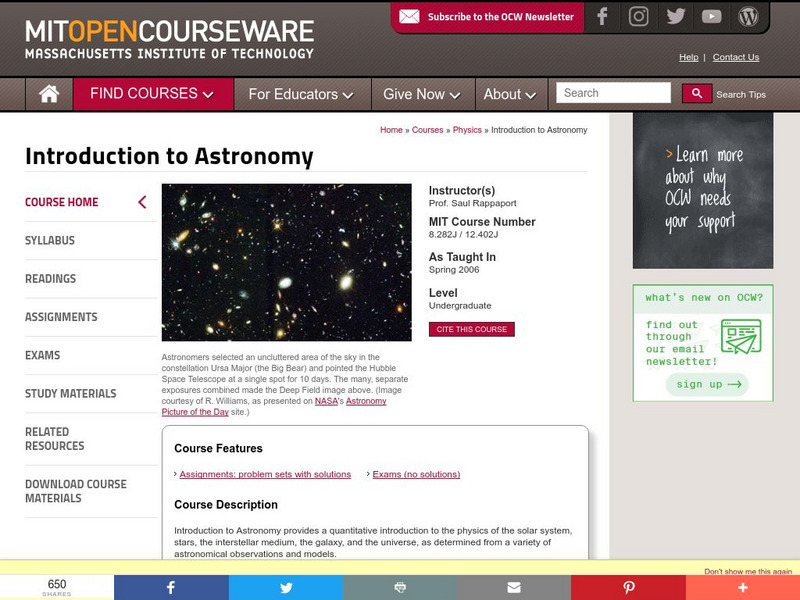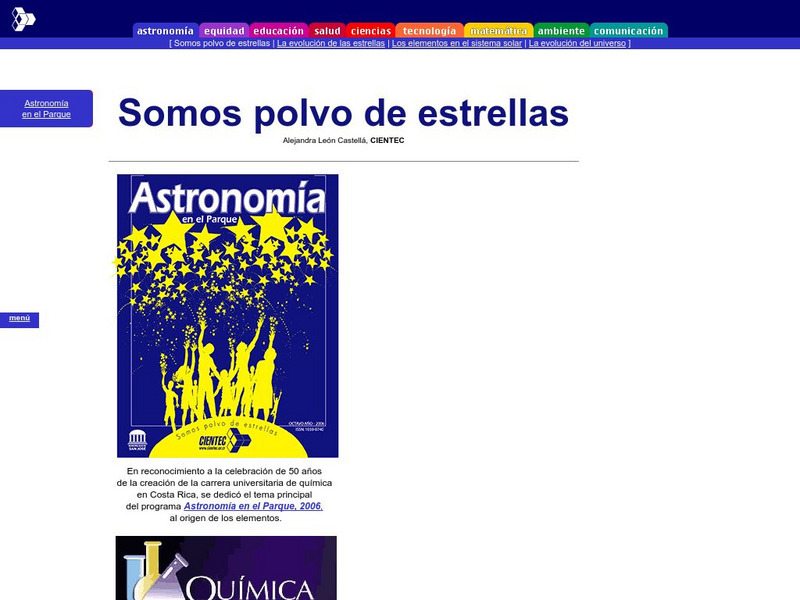European Space Agency
European Space Agency: Esa Kids: Our Universe: Jupiter
A basic overview of the planet Jupiter. Links to information about the other planets and objects in our solar system are included.
Harvard University
Harvard University: The Sun
Includes a brief history of the sun's development and its future. Also provides simple statistics, solar activities, and references.
Massachusetts Institute of Technology
Mit: Open Course Ware: Courses: Physics: Introduction to Astronomy
A university-level introduction to basic astronomy. Includes course readings, assignments, exams, and study notes with links to images and to biographical profiles of famous astronomers.
Massachusetts Institute of Technology
Mit: Open Course Ware: Courses: Extrasolar Planets: Physics and Detection
A university-level course that examines the atmospheres and interiors of extrasolar planets, or exoplanets. The course also looks at the search for planets that could support life. Includes lecture notes and assignments.
Other
Celestia
This site provides a free space simulation that lets you explore the universe in three dimensions. There is a forum for teachers and lesson plans that help enhance student use of the simulation. A program must be downloaded in order to...
Sophia Learning
Sophia: Space Sciences: Introduction to the Mars Science Laboratory
Created to teach students of the 21st century, SOPHIA is bringing Mars straight to your fingertips. Discover what scientific discoveries are occurring in the rest of the universe with this interactive tutorial.
NASA
Nasa: Imagine the Universe: The History of Gamma Ray Astronomy
This NASA article discusses the history of gamma-ray astronomy. Related resources.
University of Texas at Austin
The University of Texas Mc Donald Observatory: Neptune
Discover interesting facts about Neptune, the fourth-largest planet.
University of Texas at Austin
The University of Texas Mc Donald Observatory: Uranus
Learn interesting facts about the planet Uranus and its unique history.
University of Texas at Austin
The University of Texas Mc Donald Observatory: Mars
Discover interesting facts about Mars, the furthest planet from the sun.
University of Texas at Austin
The University of Texas Mc Donald Observatory: Venus
Discover interesting facts about Venus, the hottest planet and the second planet from the Sun.
University of Texas at Austin
The University of Texas Mc Donald Observatory: Mercury
Discover interesting facts about the tiny planet Mercury, the closest planet to the Sun.
University of Texas at Austin
The University of Texas Mc Donald Observatory: Pluto
Discover interesting information about Pluto, a member of the Kuiper Belt and no longer a planet since 2006.
University of Texas at Austin
The University of Texas Mc Donald Observatory: Meteorites
Discover fascinating facts about meteorites, pieces of asteroids that originate in outer space and survives their passage through the atmosphere to reach the ground.
University of Texas at Austin
The University of Texas Mc Donald Observatory: Comets
Discover interesting facts about comets, an icy time capsule left over from the birth of planets.
University of Texas at Austin
The University of Texas Mc Donald Observatory: Earth
Learn interesting information about the Earth, the largest of the "terrestrial" planets.
Curated OER
University of Maryland: The Astronomy Workshop
Find tools to calculate astronomical distances and sizes, to view various Solar System models, to compare gravity's affect on weight, and more. A good place to find interesting facts, simple animations, and astronomy links to physics and...
Curated OER
University of Maryland: The Astronomy Workshop
Find tools to calculate astronomical distances and sizes, to view various Solar System models, to compare gravity's affect on weight, and more. A good place to find interesting facts, simple animations, and astronomy links to physics and...
Fundación Cientec
Cientec: Somos Polvo De Estrellas
Read about the evolution of the stars, the elements of the solar system and the evolution of the Universe.
Cosmo Learning
Cosmo Learning: Introduction to Astrophysics
A collection of audio lectures from an introduction to astrophysics course taught at the University of California, Berkeley. The course discusses the solar system, stars, quantum mechanics, gravitation, and cosmology focusing on how...
University of Houston
University of Houston: Atlantis: Main Idea Story 3
An exercise in finding the main idea. Read a short nonfiction paragraph about the solar system, and click on the correct main idea.
National Institute of Educational Technologies and Teacher Training (Spain)
Ministerio De Educacion: La Situacion De La Tierra en El Universo
Throughout this unit you will make an imaginary journey that will transport you from the remotest infinity of the universe around us, to the surface of our planet. During this trip you will see the main features and components of our...
Khan Academy
Khan Academy: Quiz: Looking Back
Quiz yourself on the origins of the universe and life.
Kidport
Kidport: Space Science
This complete resource will help students to improve their understand of space exploration. Includes images of the universe, galaxies, stars and planets.












